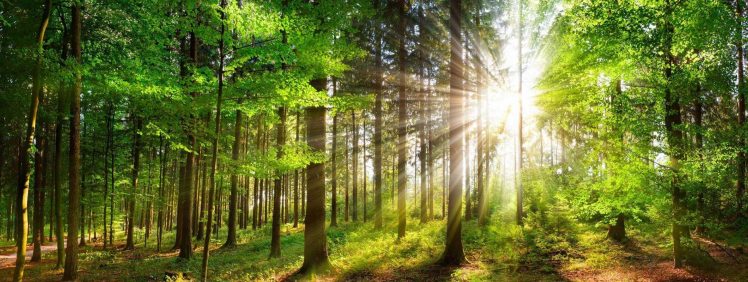What does it all mean? And how does this relate to sustainable paper?
We all know that well-managed sustainable forests have multiple benefits for our planet. Forests represent some of the richest biologically diverse areas on Earth. They play a critical role in regulating the climate, population growth and economy. And, of course, what is more soothing for the soul than a forest walk?
In 2021, the United Nations hosted the Climate Change Conference (COP26) in Glasgow. Here, they announced there would be renewed focus, and a global commitment, on the subject of Deforestation.
Deforestation
Deforestation is the activity of converting natural forests to other land use. These forests are often felled with machinery. And rather than using the timber, it is burnt. In this manner, once the forest is gone. It’s gone for good. So, it was no surprise that this announcement received resounding support. A fair amount of this support came from the paper sector, which has been committed to forest regeneration for decades. After all, no timber—no paper.
Reforestation
Reforestation is the complete opposite to Deforestation. It defines the process of renewing forests through either natural seeding or artificial planting for future use. Thus creating a sustainable cycle of renewable resources.
Through Reforestation, the paper industry plays an essential role by conducting planting, harvesting and replanting programmes. For example, Australia has 1.8 million hectares of planted forests. Over 90% of which are certified as being sustainably managed by the Forest Stewardship Council (FSC) and the Programme for the Endorsement of Forest Certification (PEFC). Equally, New Zealand has 2.1 million hectares of plantation forest, of which 57% is certified as sustainably managed. By comparison, the global average is only 12%.
Sustainable Forest Management
The paper production industry strongly supports sustainable forest management. They see Reforestation as an essential key in solving the climate change puzzle. Reforestation of planted forests not only helps conserve natural forests but also improves degraded land and reduces carbon dioxide. Thus, helping combat climate change. It also provides employment and revenue, thus supporting national economies.
Forestry certifications, such as PEFC and FSC, help to guarantee that paper comes from sustainable sources. All timber harvesting for paper production in Australia is conducted sustainably. Almost all of the original fibre for printing and communication paper comes from softwood plantations and land that has undergone Reforestation. Plus, Reforestation is critical for Australia and New Zealand to reach their respective deforestation targets. The more we source material from reforestation plantations, the less we destroy natural forests. The two are intrinsically linked.
Certification of Sustainable Forests
For Reforestation to be successful, it must be independently certified by organisations committed to sustainability. There are two primary certifications:
- Programme for the Endorsement of Forest Certification (PEFC) as represented by Responsible Wood and
- Forests Stewardship Council (FSC).
These certifications are issued at the ‘Forest Level’. This means they apply to the plantation from which the raw material (wood fibre) is sourced. Both certifications follow the material along its ‘chain of custody’. That is to say, the wood fibre is tracked as it passes hands from source to manufacturing. Thus ensuring the material remains authentic. PEFC and FSC certification programs also define and provide principles for what constitutes a well-managed ‘sustainable forest. The main point here is—for people working in and around the printing industry, supporting reforestation is a choice. Knowing paper is made from sustainably sourced material means several things:
- a reassurance against Deforestation,
- supporting a circular economy and
- protecting jobs and social projects.
All of which should provide guidance when selecting paper. Sustainability is gold!
PEFC & FSC
The majority of BJ Ball and Ball & Doggett papers are made from wood fibre from sustainable sources.
You can identify these stocks in our swatch books and on our website via these symbols:


1. Programme for the Endorsement of Forest Certification (PEFC): And
2. Forest Stewardship Council (FSC) Recycled & Forest Stewardship Council (FSC) Mix.
The Programme for the Endorsement of Forest Certification (PEFC) is a global standard that, by area, is the world’s largest forest certification scheme. PEFC is governed in Australia and NZ by Responsible Wood (formerly the Australian Forestry Standard).
The Forest Stewardship Council (FSC) was established in 1993 as an independent, non-governmental organisation to promote responsible management of the world’s forests. The organisation provides two certifications:
- FSC Recycled: ensures the paper contains 100% verified recycled material.
- FSC Mix: means the paper contains a mixture of (at least 70%) virgin fibre from an FSC Certified forest or other controlled source.
Both PEFC and the two FSC certifications require independent third-party verification.
GSM would like to thank Lily Brownbill-Stevens, @The Real Media Collective for assisting with the writing of this article.
The Real Media Collective was established to represent, promote and advocate for the users, producers and distributors of all consumer marketing channels—established and new. For more information go to: //therealmediacollective.com.au
This article was originally published in GSM18. To read this, and other great articles, purchase this issue here.


